Vascular: Venous Thromboembolism (VTE) Prophylaxis
VTE Prophylaxis
Intermittent Pneumatic Compression (IPC) Device
- Aka Sequential Compression Devices (SCD)
- Effects: Decreased Plasminogen Activator Inhibitor (PAI-1) – tPA Inhibitor
- Also Has Some Decreased Venous Stasis to a Lesser Extent
Caprini Score
- Determines Risk for VTE
- Factors:
- 1 Point: Age 41-60, Minor Surgery, BMI ≥ 30, Recent Major Surgery, Swollen Legs, Varicose Veins, Recent Sepsis, Abnormal Pulmonary Function (COPD), Recent MI, CHF, IBD, On Bed Rest, Pregnant/Post-Partum, Past Unexplained Spontaneous Abortion, Oral Contraceptives or Hormone Replacement
- 2 Points: Age 61-74 Arthroscopic Surgery, Major Open Surgery (> 45 Minutes), Laparoscopic Surgery (> 45 Minutes), History of Cancer (Except Non-Melanoma Skin Cancer), Current Cancer (Except Breast or Thyroid), Confined to Bed (> 72 Hours), Immobilizing Plaster Cast, Central Venous Access
- 3 Points: Age ≥ 75, History of VTE, Family History of VTE, Chemotherapy, Factor V Leiden, Prothrombin 20210A, Lupus Anticoagulant, Anticardiolipin Ab, Elevated Serum Homocysteine, HIT, Other Congenital or Acquired Thrombophilia
- 5 Points: Major Surgery (> 6 Hours, Recent Stroke, Elective Major Lower Extremity Arthroplasty, Recent Hip/Pelvis/Leg Fracture, Recent Acute Spinal Cord Fracture or Paralysis, Recent Multiple Traumas
- *Recent = < 1 Month
- Category:
- Score 0-4: Low Risk
- Score 5-8: Moderate Risk
- Score ≥ 9: High Risk
Management Based on Risk
- Low Risk: IPC
- Moderate-High Risk: IPC & Chemical
- CA or IBD – Extended Treatment for 4 Weeks Postop

Sequential Compression Devices 1
Chemical Prophylaxis
Heparin (Unfractionated Heparin)
- Dosing: 5,000 U Every 8 Hours
Lovenox (Low Molecular Weight Heparin)
- Dosing: *See Below
- Comparison to Heparin:
- Generally Considered More Effective, Especially in Trauma Patients
- Similar Mortality
- Larger Dosing Required for Obese Patients
- Contraindicated for Severe Renal Insufficiency (CrCl < 30 mL/min)
- *Some Prefer Lower Dosing But Still Use
Lovenox Dosing
- General: 40 mg Every 24 Hours
- Obese: Debated
- BMI ≥ 40: 40 mg Every 12 Hours
- BMI ≥ 50: 60 mg Every 12 Hours
- Trauma: 40 mg Every 12 Hours
- Indications for 30 mg Every 12 Hours Dosing:
- > 65 Years Old
- Low Weight
- TBI or Spinal Cord Injury
- Pregnancy
- Consider Adjusting by Anti-Xa Laboratory Monitoring
- Goal Peak Levels: 0.2-0.5 IU/mL (Debated)
- Goal Trough Levels: 0.1-0.2 IU/mL (Debated)
- *Historically 30 mg BID was the Dose for All Trauma Patients – Newer Data Show Inadequate Prophylaxis
- Indications for 30 mg Every 12 Hours Dosing:
- Cancer Patients: Consider Increased Dosing (Debated)
Other Options
- Dalteparin
- Tinzaparin
- Nadroparin
References
- Koo KH, Choi JS, Ahn JH, Kwon JH, Cho KT. Comparison of clinical and physiological efficacies of different intermittent sequential pneumatic compression devices in preventing deep vein thrombosis: a prospective randomized study. Clin Orthop Surg. 2014 Dec;6(4):468-75. (License: CC BY-NC-3.0)